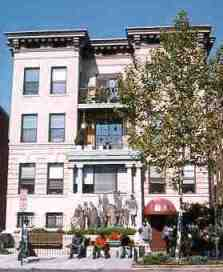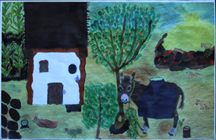By Jean Adams

Christ House is a 33 bed recuperative hospital for formerly homeless and addicted men and women. It came into existence when its physician, Dr. Janelle Goetcheus, saw the need for such a hospital, and together with her husband, Rev. Allen Goetcheus, began to tell people about it. Seekers supports this mission through our domestic giving.
By Jean Adams

Christ House located at
1717 Columbia Road, NW,
Washington, DC
After I retired from my art teaching position in a local school system I found myself missing the one-on-one relating to students, and the enjoyment in seeing the uniqueness of each student’s work.
Learning of a need for a volunteer art teacher at Christ House in Adams Morgan, in D.C., I chose to answer that need, and Seekers Church has supported my work there by providing funds for supplies and storage. Though I serve a need there, I find that I am equally nourished by the people that I work with each week.
Christ House is a 33 bed recuperative hospital for formerly homeless and addicted men and women. It came into existence when its physician, Dr. Janelle Goetcheus, saw the need for such a hospital, and together with her husband, Rev. Allen Goetcheus, began to tell people about it. Through prayer and hard work the hospital became real. It has been in existence for over 25 years, fully and appropriately staffed, and a loving atmosphere for the men and women who chose to recuperate there. Attendance at a Twelve Step meeting each day is required.
Like Seekers, Christ House is one of the scattered communities and ministries of The Church of the Saviour in the D.C.area. An ecumenical service is held every Sunday morning, led by Rev. Goetchus. It is optional for patients, though many of those able to attend do come.
So what is it like to have an Art Workshop there? We use a couple of tables in the dining room, and roll in an art cart with many supplies in it. We remind old patients, and invite new patients to come by going to the second floor nursing station for an announcement over the PA. But we also see patients in the hallway or in a sitting area, or in the TV lounge and remind them, or cajole those who are uncertain.."You can come down and have a cup of coffee and just come by and see what we are doing. You can even just sit and watch. . ."
The art work is tailored to the interest of the patient. One man wanted to work on a comic book he has been writing and illustrating for several years. The scenes of battling, armored and mounted men are superbly drawn. Horses rear, men clash swords, reinforcements gallop over the distant horizon line. He hopes to publish it someday; I hope he does, and will help if I can. Another man wanted to work in clay. He made a good replica of the mummy of Tutenkamen, meticulously handling detail. (We had to work at a table beyond the dining table area for cleanliness concerns, though afterwards everything was quite clean.)
Due to the time required for drying and firing, this piece had to be sent to the patient who had been able to go to a detox facility in West Virginia.
Sometimes the patient will just want to put color on paper. A demonstration of using poster paints, one primary color at a time, using different ways to move the brush, in long strokes from the shoulder, strokes from the elbow, from the wrist, from the fingers, are ways to see what paint can do without the patient having to "paint a picture". After the patient tries this, he sees how one color changes another, how the marks of a fully loaded brush, or an almost dry brush can make different effects, and usually wants to try painting on another paper. Sometimes he will have a subject in mind, sometimes it is another colorful abstract.

G.T.’s painting tells a rich story of rural living.
Occasionally a patient will want to paint every day. They are given paints, brushes and paper to use in their room. One of these men was "G.T", who was Eritrean. His stay at Christ House was a long one, as it was discovered after he had arrived and healed a wound, that he had a throat cancer which was inoperable. Many of G.T.’s paintings were of the Holy Family. In them there was always a donkey. One of his paintings seemed to be a village scene. A donkey is chained to a tree by a small house. Behind the donkey is a low stone wall which surrounds a rounded pile of cut grass or hay. On the wall we see a lizard and a small goat. Another goat is in the yard. Chickens are about. There is a field of corn.
I love this painting. It tells the story of a real place. I asked G.T. if he had known donkeys as he was growing up. He had. The face of the donkey is looking right at the viewer, and was painted with such realistic details! Who could doubt that this artist’s hands had stroked the broad nose of a donkey and looked into its long-lashed dark brown eyes with the great attention of a young child.
At Christ House, and a long way from his village, G.T. found a caring family and a home.